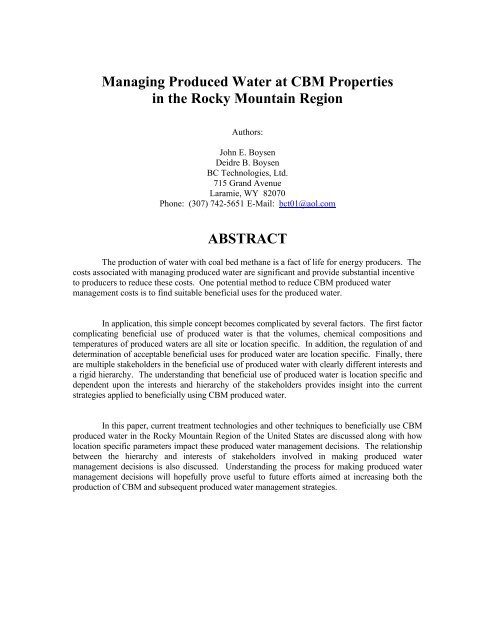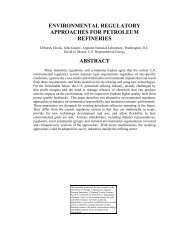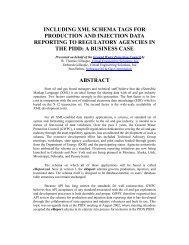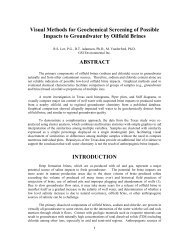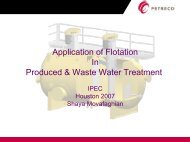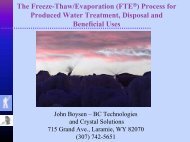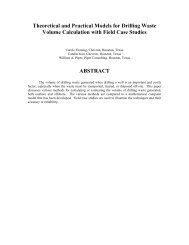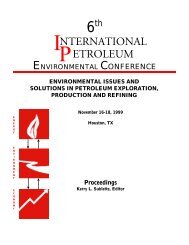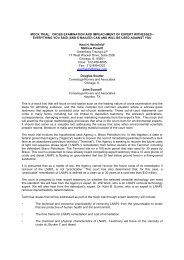Managing Produced Water at CBM Properties in the Rocky ... - IPEC
Managing Produced Water at CBM Properties in the Rocky ... - IPEC
Managing Produced Water at CBM Properties in the Rocky ... - IPEC
Create successful ePaper yourself
Turn your PDF publications into a flip-book with our unique Google optimized e-Paper software.
<strong>Manag<strong>in</strong>g</strong> <strong>Produced</strong> <strong>W<strong>at</strong>er</strong> <strong>at</strong> <strong>CBM</strong> <strong>Properties</strong><br />
<strong>in</strong> <strong>the</strong> <strong>Rocky</strong> Mounta<strong>in</strong> Region<br />
Authors:<br />
John E. Boysen<br />
Deidre B. Boysen<br />
BC Technologies, Ltd.<br />
715 Grand Avenue<br />
Laramie, WY 82070<br />
Phone: (307) 742-5651 E-Mail: bct01@aol.com<br />
ABSTRACT<br />
The production of w<strong>at</strong>er with coal bed methane is a fact of life for energy producers. The<br />
costs associ<strong>at</strong>ed with manag<strong>in</strong>g produced w<strong>at</strong>er are significant and provide substantial <strong>in</strong>centive<br />
to producers to reduce <strong>the</strong>se costs. One potential method to reduce <strong>CBM</strong> produced w<strong>at</strong>er<br />
management costs is to f<strong>in</strong>d suitable beneficial uses for <strong>the</strong> produced w<strong>at</strong>er.<br />
In applic<strong>at</strong>ion, this simple concept becomes complic<strong>at</strong>ed by several factors. The first factor<br />
complic<strong>at</strong><strong>in</strong>g beneficial use of produced w<strong>at</strong>er is th<strong>at</strong> <strong>the</strong> volumes, chemical compositions and<br />
temper<strong>at</strong>ures of produced w<strong>at</strong>ers are all site or loc<strong>at</strong>ion specific. In addition, <strong>the</strong> regul<strong>at</strong>ion of and<br />
determ<strong>in</strong><strong>at</strong>ion of acceptable beneficial uses for produced w<strong>at</strong>er are loc<strong>at</strong>ion specific. F<strong>in</strong>ally, <strong>the</strong>re<br />
are multiple stakeholders <strong>in</strong> <strong>the</strong> beneficial use of produced w<strong>at</strong>er with clearly different <strong>in</strong>terests and<br />
a rigid hierarchy. The understand<strong>in</strong>g th<strong>at</strong> beneficial use of produced w<strong>at</strong>er is loc<strong>at</strong>ion specific and<br />
dependent upon <strong>the</strong> <strong>in</strong>terests and hierarchy of <strong>the</strong> stakeholders provides <strong>in</strong>sight <strong>in</strong>to <strong>the</strong> current<br />
str<strong>at</strong>egies applied to beneficially us<strong>in</strong>g <strong>CBM</strong> produced w<strong>at</strong>er.<br />
In this paper, current tre<strong>at</strong>ment technologies and o<strong>the</strong>r techniques to beneficially use <strong>CBM</strong><br />
produced w<strong>at</strong>er <strong>in</strong> <strong>the</strong> <strong>Rocky</strong> Mounta<strong>in</strong> Region of <strong>the</strong> United St<strong>at</strong>es are discussed along with how<br />
loc<strong>at</strong>ion specific parameters impact <strong>the</strong>se produced w<strong>at</strong>er management decisions. The rel<strong>at</strong>ionship<br />
between <strong>the</strong> hierarchy and <strong>in</strong>terests of stakeholders <strong>in</strong>volved <strong>in</strong> mak<strong>in</strong>g produced w<strong>at</strong>er<br />
management decisions is also discussed. Understand<strong>in</strong>g <strong>the</strong> process for mak<strong>in</strong>g produced w<strong>at</strong>er<br />
management decisions will hopefully prove useful to future efforts aimed <strong>at</strong> <strong>in</strong>creas<strong>in</strong>g both <strong>the</strong><br />
production of <strong>CBM</strong> and subsequent produced w<strong>at</strong>er management str<strong>at</strong>egies.
INTRODUCTION<br />
At <strong>the</strong> present time, <strong>the</strong> production of w<strong>at</strong>er with coal bed n<strong>at</strong>ural gas is an accepted fact of<br />
life for energy producers. The cost to transport, tre<strong>at</strong> and/or dispose of this w<strong>at</strong>er <strong>in</strong>creases <strong>the</strong> cost<br />
of produc<strong>in</strong>g energy from a well. In economically marg<strong>in</strong>al low-productivity form<strong>at</strong>ions, <strong>the</strong> costs<br />
rel<strong>at</strong>ed to w<strong>at</strong>er management can prevent a well from be<strong>in</strong>g completed or can cause produc<strong>in</strong>g wells<br />
to be shut <strong>in</strong>. In addition, <strong>the</strong> future production of oil and gas is expected to <strong>in</strong>creas<strong>in</strong>gly depend<br />
upon production from economically marg<strong>in</strong>al form<strong>at</strong>ions and from unconventional sources of oil<br />
and gas. One promis<strong>in</strong>g unconventional source of n<strong>at</strong>ural gas is methane production from coal<br />
seams. Like production from economically marg<strong>in</strong>al resources, <strong>the</strong> production of methane from<br />
coal seams may rely <strong>in</strong> <strong>the</strong> future upon a cost-effective method for tre<strong>at</strong>ment or disposal of<br />
produced w<strong>at</strong>er.<br />
Currently <strong>in</strong> <strong>the</strong> oil and gas <strong>in</strong>dustry, produced w<strong>at</strong>er is accepted as a liability. However,<br />
as problems represent challenges, produced w<strong>at</strong>er management represents both a significant<br />
oper<strong>at</strong><strong>in</strong>g expense and a potential opportunity to reduce production costs. Any reduction <strong>in</strong> <strong>the</strong><br />
cost of produced w<strong>at</strong>er management will <strong>in</strong>crease <strong>the</strong> net profit from a well. To this degree,<br />
reduc<strong>in</strong>g <strong>the</strong> cost of w<strong>at</strong>er management represents a significant means of <strong>in</strong>creas<strong>in</strong>g profits and<br />
also of produc<strong>in</strong>g a resource.<br />
Reduc<strong>in</strong>g <strong>the</strong> cost of produced w<strong>at</strong>er management represents both a means of <strong>in</strong>creas<strong>in</strong>g<br />
<strong>the</strong> bottom l<strong>in</strong>e for energy producers and a means to enable future production of energy resources.<br />
These two reasons alone provide ample <strong>in</strong>centive for producers to optimize <strong>the</strong>ir produced w<strong>at</strong>er<br />
management plann<strong>in</strong>g effort. However, determ<strong>in</strong><strong>in</strong>g <strong>the</strong> answer to wh<strong>at</strong> makes produced w<strong>at</strong>er a<br />
resource, and who would view it as a resource are valid questions. A beneficial use or need for<br />
<strong>the</strong> w<strong>at</strong>er can make produced w<strong>at</strong>er a resource, and any stakeholder <strong>in</strong> <strong>the</strong> energy development<br />
process th<strong>at</strong> has a beneficial use for <strong>the</strong> w<strong>at</strong>er will consider it a resource.<br />
OVERVIEW OF <strong>CBM</strong> WATER PRODUCTION<br />
VOLUMES AND LOCATION-SPECIFIC<br />
WATER MANAGEMENT PRACTICES<br />
The produced w<strong>at</strong>er volumes and associ<strong>at</strong>ed w<strong>at</strong>er management practices <strong>at</strong> coal bed<br />
n<strong>at</strong>ural gas produc<strong>in</strong>g bas<strong>in</strong>s <strong>in</strong> <strong>the</strong> <strong>Rocky</strong> Mounta<strong>in</strong> region reported <strong>in</strong> this paper were g<strong>at</strong>hered<br />
dur<strong>in</strong>g <strong>the</strong> period of 1998 – 2002 as a component of a study on produced w<strong>at</strong>er management<br />
practices funded by <strong>the</strong> Gas Research Institute. D<strong>at</strong>a from production reports offered on st<strong>at</strong>e<br />
agency websites was collected and entered <strong>in</strong>to a d<strong>at</strong>abase developed by BC Technologies, Ltd.<br />
D<strong>at</strong>abase reports connected annual w<strong>at</strong>er production volumes <strong>at</strong> specific well loc<strong>at</strong>ions with<br />
producers. Us<strong>in</strong>g this <strong>in</strong>form<strong>at</strong>ion, a sample group of oper<strong>at</strong>ors who reported high volumes of<br />
w<strong>at</strong>er <strong>in</strong> <strong>the</strong> bas<strong>in</strong>s of <strong>in</strong>terest was developed. Producers on th<strong>at</strong> list were <strong>in</strong>terviewed by<br />
telephone to f<strong>in</strong>d out how <strong>the</strong>y managed produced w<strong>at</strong>er gener<strong>at</strong>ed <strong>at</strong> <strong>the</strong>ir leases. <strong>Produced</strong><br />
w<strong>at</strong>er volumes and actual w<strong>at</strong>er management practices as <strong>the</strong>y were described dur<strong>in</strong>g <strong>in</strong>terviews
<strong>in</strong> 2000 – 2001 are provided for <strong>the</strong> Powder River Bas<strong>in</strong> of nor<strong>the</strong>astern Wyom<strong>in</strong>g and<br />
sou<strong>the</strong>astern Montana, <strong>the</strong> R<strong>at</strong>on Bas<strong>in</strong> <strong>in</strong> sou<strong>the</strong>rn Colorado, <strong>the</strong> San Juan Bas<strong>in</strong> <strong>in</strong> southwestern<br />
Colorado, <strong>the</strong> Ferron Coal Trend <strong>in</strong> <strong>the</strong> U<strong>in</strong>ta Bas<strong>in</strong> <strong>in</strong> eastern Utah, <strong>the</strong> Gre<strong>at</strong>er Green River<br />
Bas<strong>in</strong> <strong>in</strong> southwestern Wyom<strong>in</strong>g, and <strong>the</strong> Hanna Bas<strong>in</strong> <strong>in</strong> central Wyom<strong>in</strong>g.<br />
Powder River Bas<strong>in</strong><br />
In 2001, st<strong>at</strong>istics g<strong>at</strong>hered from <strong>the</strong> Wyom<strong>in</strong>g Oil and Gas Conserv<strong>at</strong>ion Commission<br />
<strong>in</strong>dic<strong>at</strong>ed th<strong>at</strong> about 60 producers were oper<strong>at</strong><strong>in</strong>g approxim<strong>at</strong>ely 9,000 wells <strong>in</strong> <strong>the</strong> Powder River<br />
Bas<strong>in</strong>. These wells produced <strong>in</strong> excess of 254,000,000 mcf gas and 506,000,000 barrels of w<strong>at</strong>er.<br />
Producers who responded to <strong>the</strong> <strong>in</strong>terviews reported us<strong>in</strong>g a variety of str<strong>at</strong>egies to manage <strong>the</strong><br />
w<strong>at</strong>er <strong>the</strong>y gener<strong>at</strong>ed dur<strong>in</strong>g <strong>CBM</strong> production. Because <strong>the</strong> produced w<strong>at</strong>er gener<strong>at</strong>ed <strong>at</strong> this time<br />
was considered very clean and was able to meet Environmental Protection Agency (EPA) w<strong>at</strong>er<br />
quality standards for surface discharge, many oper<strong>at</strong>ors reported obta<strong>in</strong><strong>in</strong>g N<strong>at</strong>ional Pollutant<br />
Discharge and Elim<strong>in</strong><strong>at</strong>ion System (NPDES) permits to discharge <strong>CBM</strong> w<strong>at</strong>er <strong>in</strong>to nearby n<strong>at</strong>ural<br />
dra<strong>in</strong>ages. This was an extremely low cost str<strong>at</strong>egy and was <strong>the</strong> most frequently cited method for<br />
dispos<strong>in</strong>g <strong>CBM</strong> produced w<strong>at</strong>er <strong>in</strong> this bas<strong>in</strong>. O<strong>the</strong>r w<strong>at</strong>er management str<strong>at</strong>egies <strong>in</strong> this bas<strong>in</strong><br />
<strong>in</strong>cluded construct<strong>in</strong>g impoundments to store w<strong>at</strong>er for irrig<strong>at</strong>ion <strong>in</strong> <strong>the</strong> Spr<strong>in</strong>g and Summer<br />
months, develop<strong>in</strong>g livestock and wildlife w<strong>at</strong>er<strong>in</strong>g ponds; utiliz<strong>in</strong>g Class II <strong>in</strong>jection wells and<br />
Class V aquifer recharge wells, and construct<strong>in</strong>g <strong>in</strong>filtr<strong>at</strong>ion ponds, evapor<strong>at</strong>ion ponds and<br />
mist<strong>in</strong>g towers.<br />
In sou<strong>the</strong>astern Montana, <strong>at</strong> <strong>the</strong> CX Field <strong>in</strong> <strong>the</strong> Powder River Bas<strong>in</strong>, two producers were<br />
actively develop<strong>in</strong>g coal bed n<strong>at</strong>ural gas <strong>in</strong> 2001. One producer oper<strong>at</strong>ed about 233 wells while<br />
<strong>the</strong> o<strong>the</strong>r oper<strong>at</strong>ed five wildc<strong>at</strong> wells nearby. They reported produc<strong>in</strong>g approxim<strong>at</strong>ely 8,000,000<br />
mcf gas and 19,000,000 barrels of w<strong>at</strong>er. Str<strong>at</strong>egies employed by this producer to manage <strong>the</strong><br />
w<strong>at</strong>er were varied and <strong>in</strong>cluded surface discharge us<strong>in</strong>g an NPDES permit; irrig<strong>at</strong>ion of n<strong>at</strong>ive<br />
grasses; development of livestock ponds; aquifer recharge through <strong>in</strong>jection <strong>in</strong>to a Class V well;<br />
and for dust suppression <strong>at</strong> a nearby coal m<strong>in</strong>e. <strong>Produced</strong> w<strong>at</strong>er was also used for local highway<br />
construction projects.<br />
R<strong>at</strong>on Bas<strong>in</strong><br />
There were approxim<strong>at</strong>ely ten producers <strong>in</strong> <strong>the</strong> R<strong>at</strong>on Bas<strong>in</strong> (Colorado side) <strong>in</strong> 2001.<br />
These producers reported oper<strong>at</strong><strong>in</strong>g about 1,000 wells and gener<strong>at</strong><strong>in</strong>g approxim<strong>at</strong>ely 76,943,000<br />
mcf gas and 69,276,000 barrels of w<strong>at</strong>er <strong>at</strong> <strong>the</strong>ir <strong>CBM</strong> properties. They reported manag<strong>in</strong>g th<strong>at</strong><br />
w<strong>at</strong>er beneficially by develop<strong>in</strong>g stock ponds and recycl<strong>in</strong>g <strong>the</strong> w<strong>at</strong>er for dust suppression and<br />
hydraulic fractur<strong>in</strong>g. They also disposed <strong>the</strong> w<strong>at</strong>er by discharg<strong>in</strong>g it to n<strong>at</strong>ural dra<strong>in</strong>ages under an<br />
NPDES permit, evapor<strong>at</strong><strong>in</strong>g it, or allow<strong>in</strong>g it to percol<strong>at</strong>e <strong>in</strong>to <strong>the</strong> ground <strong>in</strong> <strong>in</strong>filtr<strong>at</strong>ion ponds.<br />
On <strong>the</strong> New Mexico side of <strong>the</strong> bas<strong>in</strong>, <strong>the</strong>re was only one producer <strong>in</strong> 2001 who oper<strong>at</strong>ed about<br />
148 wells. These wells gener<strong>at</strong>ed about 5,385,000 mcf gas and 4,630,000 barrels of produced<br />
w<strong>at</strong>er. This w<strong>at</strong>er was disposed by re<strong>in</strong>jection <strong>in</strong>to Class II wells and beneficially used for<br />
hydraulic fractur<strong>in</strong>g, completions and workovers.<br />
San Juan Bas<strong>in</strong>
The Ignacio Blanco Field, which is known for <strong>the</strong> production of coal bed methane, is<br />
loc<strong>at</strong>ed <strong>in</strong> <strong>the</strong> San Juan Bas<strong>in</strong> <strong>in</strong> <strong>the</strong> southwestern corner of Colorado. In 2001, <strong>the</strong>re were 43<br />
producers oper<strong>at</strong><strong>in</strong>g approxim<strong>at</strong>ely 2,000 wells <strong>at</strong> this field. Toge<strong>the</strong>r, <strong>the</strong>y gener<strong>at</strong>ed about 2600<br />
barrels of oil; 424,000,000 mcf gas and over 27,000,000 barrels of w<strong>at</strong>er. <strong>CBM</strong> wells loc<strong>at</strong>ed on<br />
<strong>the</strong> New Mexico side of <strong>the</strong> bas<strong>in</strong> were not exam<strong>in</strong>ed for this study.<br />
Producers who responded to <strong>in</strong>terviews about <strong>the</strong>ir w<strong>at</strong>er management str<strong>at</strong>egies reported<br />
th<strong>at</strong> most w<strong>at</strong>er is re<strong>in</strong>jected <strong>in</strong>to Class II salt w<strong>at</strong>er disposal wells. Some producers reported <strong>the</strong><br />
use of commercial <strong>in</strong>jection wells, o<strong>the</strong>rs <strong>the</strong> use of company owned disposal wells. Some used<br />
company-owned pipel<strong>in</strong>e systems, while o<strong>the</strong>rs relied on commercial w<strong>at</strong>er haul<strong>in</strong>g services.<br />
Economics and <strong>the</strong> geographical loc<strong>at</strong>ion of well sites were frequently noted as <strong>the</strong> reason to<br />
select one str<strong>at</strong>egy over ano<strong>the</strong>r. Evapor<strong>at</strong>ion was also cited. In this bas<strong>in</strong>, producers reported<br />
<strong>the</strong> use of commercial disposal pits, company-owned pits, and evapor<strong>at</strong>ion tanks. Both active and<br />
passive evapor<strong>at</strong>ion str<strong>at</strong>egies were reported. Active evapor<strong>at</strong>ion <strong>in</strong>volves <strong>the</strong> use of sprays to<br />
enhance <strong>the</strong> disposal process, while passive evapor<strong>at</strong>ion relied on clim<strong>at</strong>ic conditions. Some<br />
producers also reported beneficially us<strong>in</strong>g <strong>CBM</strong> w<strong>at</strong>er for drill<strong>in</strong>g mix, make up w<strong>at</strong>er and hot oil<br />
tre<strong>at</strong>ments. None of <strong>the</strong> producers who responded to <strong>the</strong> survey reported us<strong>in</strong>g surface discharge<br />
<strong>in</strong> this bas<strong>in</strong>, although one producer said his company had obta<strong>in</strong>ed an NPDES permit th<strong>at</strong><br />
required tre<strong>at</strong><strong>in</strong>g <strong>the</strong> produced w<strong>at</strong>er before discharge. Tre<strong>at</strong>ment with a reverse osmosis system<br />
was <strong>at</strong>tempted, but did not achieve <strong>the</strong> results needed to discharge <strong>the</strong> w<strong>at</strong>er.<br />
U<strong>in</strong>ta Bas<strong>in</strong><br />
The Ferron Coal Trend is loc<strong>at</strong>ed <strong>in</strong> <strong>the</strong> U<strong>in</strong>ta Bas<strong>in</strong> <strong>in</strong> eastern Utah. Coal bed methane<br />
gas producers <strong>in</strong> this bas<strong>in</strong> reported gener<strong>at</strong><strong>in</strong>g high volumes of w<strong>at</strong>er <strong>in</strong> rel<strong>at</strong>ionship to <strong>the</strong><br />
volume of gas, yet managed to keep <strong>the</strong>ir w<strong>at</strong>er disposal costs low by utiliz<strong>in</strong>g pipel<strong>in</strong>es and<br />
company owned <strong>in</strong>jection wells. Four <strong>CBM</strong> fields <strong>in</strong> this bas<strong>in</strong> were exam<strong>in</strong>ed dur<strong>in</strong>g <strong>the</strong> Gas<br />
Research Institute study. These fields are Castleg<strong>at</strong>e, Helper, Drunkards Wash and Buzzard<br />
Bench.<br />
Castleg<strong>at</strong>e Field is loc<strong>at</strong>ed <strong>in</strong> <strong>the</strong> north-central portion of Carbon County, Utah. In 2001,<br />
<strong>the</strong>re was one oper<strong>at</strong>or produc<strong>in</strong>g 17 wells <strong>at</strong> th<strong>at</strong> field. Those wells yielded approxim<strong>at</strong>ely<br />
290,000 mcf gas and 546,000 barrels of w<strong>at</strong>er. All w<strong>at</strong>er <strong>at</strong> this field is disposed of by pipel<strong>in</strong>e<br />
<strong>in</strong>to a company-owned disposal well.<br />
At <strong>the</strong> Helper Field, which is also loc<strong>at</strong>ed <strong>in</strong> Carbon County, Utah, one producer oper<strong>at</strong>ed<br />
about 99 <strong>CBM</strong> wells <strong>in</strong> 2001. These wells yielded approxim<strong>at</strong>ely 10,000,000 mcf gas and about<br />
3,000,000 barrels of w<strong>at</strong>er. The oper<strong>at</strong>or <strong>at</strong> th<strong>at</strong> field reported pump<strong>in</strong>g <strong>the</strong> produced w<strong>at</strong>er via<br />
pipel<strong>in</strong>e to a company-owned disposal well, where it is filtered before <strong>in</strong>jection, and disposed.<br />
Reverse osmosis was <strong>at</strong>tempted <strong>at</strong> this field but was deemed too expensive and abandoned as a<br />
w<strong>at</strong>er management str<strong>at</strong>egy.
Drunkards Wash is also loc<strong>at</strong>ed <strong>in</strong> <strong>the</strong> southwestern corner of Carbon County, UT. In<br />
2001, <strong>the</strong>re were three coal bed methane producers oper<strong>at</strong><strong>in</strong>g <strong>at</strong> this field. Toge<strong>the</strong>r, <strong>the</strong>y<br />
produced over 400 wells from <strong>the</strong> Ferron Sandstone Form<strong>at</strong>ion, and reported about 78,000,000<br />
mcf gas and 24,000,000 barrels of w<strong>at</strong>er. Two of <strong>the</strong> three producers (who toge<strong>the</strong>r produced<br />
99% of <strong>the</strong> w<strong>at</strong>er reported) were <strong>in</strong>terviewed by telephone and <strong>the</strong>y reported th<strong>at</strong> all w<strong>at</strong>er <strong>the</strong>y<br />
gener<strong>at</strong>e is disposed <strong>in</strong>to company-owned <strong>in</strong>jection wells. One of <strong>the</strong> oper<strong>at</strong>ors reported th<strong>at</strong> <strong>the</strong>y<br />
do not beneficially use any of <strong>the</strong> produced w<strong>at</strong>er because <strong>the</strong> quality is too poor. He reported<br />
th<strong>at</strong> <strong>the</strong> company had tried reverse osmosis to tre<strong>at</strong> <strong>the</strong> w<strong>at</strong>er so th<strong>at</strong> it could be reused, but th<strong>at</strong> it<br />
was too expensive <strong>at</strong> <strong>the</strong> time. The o<strong>the</strong>r oper<strong>at</strong>or also reported us<strong>in</strong>g a w<strong>at</strong>er g<strong>at</strong>her<strong>in</strong>g system<br />
and re<strong>in</strong>jection and th<strong>at</strong> <strong>the</strong>y also recycle some of <strong>the</strong> w<strong>at</strong>er for workovers and drill<strong>in</strong>g activities.<br />
Buzzard Bench is loc<strong>at</strong>ed <strong>in</strong> <strong>the</strong> northwestern corner of Emery County, Utah. In 2001<br />
<strong>the</strong>re were over fifty actively produc<strong>in</strong>g <strong>CBM</strong> wells th<strong>at</strong> gener<strong>at</strong>ed about 3,000,000 mcf gas and<br />
2,000,000 barrels of w<strong>at</strong>er. Although two oper<strong>at</strong>ors reported production <strong>at</strong> this field, one of <strong>the</strong>m<br />
gener<strong>at</strong>ed almost 100% of <strong>the</strong> w<strong>at</strong>er. Th<strong>at</strong> producer was <strong>in</strong>terviewed by telephone and reported<br />
th<strong>at</strong> all w<strong>at</strong>er is conveyed by pipel<strong>in</strong>e to company-owned <strong>in</strong>jection wells.<br />
Green River Bas<strong>in</strong><br />
Coalbed methane explor<strong>at</strong>ion and development is new to southwestern Wyom<strong>in</strong>g, with<br />
few wells actively produc<strong>in</strong>g <strong>at</strong> this time. The follow<strong>in</strong>g <strong>in</strong>form<strong>at</strong>ion provides a brief summary of<br />
<strong>the</strong> scope of <strong>the</strong> development and <strong>the</strong> associ<strong>at</strong>ed proposed w<strong>at</strong>er management plans.<br />
The Lower Bush Creek Coal Bed Methane Explor<strong>at</strong>ory Pilot Project was proposed to <strong>the</strong><br />
BLM by Kennedy Oil <strong>in</strong> February 2002. They anticip<strong>at</strong>ed drill<strong>in</strong>g 20 explor<strong>at</strong>ory <strong>CBM</strong> wells <strong>in</strong><br />
<strong>the</strong> Green River Bas<strong>in</strong> to test <strong>the</strong> commercial coalbed methane production potential of <strong>the</strong> Big<br />
Red coal seam. Their w<strong>at</strong>er management str<strong>at</strong>egy <strong>in</strong>volved <strong>the</strong> development of a pipel<strong>in</strong>e system<br />
th<strong>at</strong> would convey <strong>the</strong> w<strong>at</strong>er to two disposal wells.<br />
The Hay Reservoir Coalbed N<strong>at</strong>ural Gas Pilot Project was proposed to <strong>the</strong> BLM by<br />
Kennedy Oil <strong>in</strong> September 2003. They proposed construction, drill<strong>in</strong>g, completion and<br />
production of eight <strong>CBM</strong> wells <strong>in</strong> <strong>the</strong> Green River Bas<strong>in</strong>. Accord<strong>in</strong>g to <strong>the</strong>ir proposed w<strong>at</strong>er<br />
management plan, produced w<strong>at</strong>er gener<strong>at</strong>ed from <strong>the</strong>se <strong>CBM</strong> wells will be disposed <strong>in</strong>to an<br />
<strong>in</strong>jection well th<strong>at</strong> will also be drilled on <strong>the</strong> site.<br />
The Pappy Draw Explor<strong>at</strong>ory Coalbed N<strong>at</strong>ural Gas Project was proposed to <strong>the</strong> BLM by<br />
P<strong>at</strong><strong>in</strong>a Oil and Gas Corpor<strong>at</strong>ion <strong>in</strong> July 2002. P<strong>at</strong><strong>in</strong>a proposed drill<strong>in</strong>g 15 explor<strong>at</strong>ory wells th<strong>at</strong><br />
would be loc<strong>at</strong>ed <strong>in</strong> <strong>the</strong> Green River Bas<strong>in</strong>. The pilot project is designed to identify several<br />
fe<strong>at</strong>ures of <strong>the</strong> coal <strong>in</strong>clud<strong>in</strong>g <strong>the</strong> volume of w<strong>at</strong>er and <strong>the</strong> de-w<strong>at</strong>er<strong>in</strong>g characteristic of <strong>the</strong> coal.<br />
The d<strong>at</strong>a gener<strong>at</strong>ed dur<strong>in</strong>g <strong>the</strong> pilot will be used to determ<strong>in</strong>e <strong>the</strong> economics of <strong>the</strong> project and <strong>the</strong><br />
produced w<strong>at</strong>er disposal method. At <strong>the</strong> time <strong>the</strong> scop<strong>in</strong>g notice was issued, P<strong>at</strong><strong>in</strong>a was explor<strong>in</strong>g<br />
several w<strong>at</strong>er management str<strong>at</strong>egies.
The Atlantic Rim Coalbed Methane Project was proposed to <strong>the</strong> BLM <strong>in</strong> February 2000<br />
by Stone and Wolf, LLC and <strong>in</strong>volved explor<strong>in</strong>g and potentially develop<strong>in</strong>g 96 coalbed wells <strong>in</strong><br />
<strong>the</strong> Green River Bas<strong>in</strong>. Their plan <strong>in</strong>volved drill<strong>in</strong>g <strong>the</strong> wells <strong>in</strong> three areas to determ<strong>in</strong>e if <strong>the</strong><br />
coals were gas productive, if <strong>the</strong>y could be drilled economically, if dew<strong>at</strong>er<strong>in</strong>g of <strong>the</strong> coals could<br />
be achieved, and wh<strong>at</strong> depths or pressure w<strong>in</strong>dows would result <strong>in</strong> <strong>the</strong> most economic gas<br />
production. Dur<strong>in</strong>g <strong>the</strong> prepar<strong>at</strong>ion of <strong>the</strong> Environmental Assessment, Stone and Wolf, LLC sold<br />
<strong>the</strong>ir oper<strong>at</strong><strong>in</strong>g rights to Petroleum Development Corpor<strong>at</strong>ion and <strong>in</strong> may 2001, Petroleum<br />
Development Corpor<strong>at</strong>ion withdrew its applic<strong>at</strong>ion for <strong>the</strong> 96 well project and submitted a new<br />
proposal for <strong>the</strong> development of potentially 3880 <strong>CBM</strong> wells, which would be loc<strong>at</strong>ed north of<br />
<strong>the</strong> orig<strong>in</strong>al well site. They anticip<strong>at</strong>ed <strong>the</strong> use of w<strong>at</strong>er g<strong>at</strong>her<strong>in</strong>g systems th<strong>at</strong> would convey <strong>the</strong><br />
w<strong>at</strong>er to an off-channel reservoir.<br />
Hanna Bas<strong>in</strong><br />
The Sem<strong>in</strong>oe Road Gas Development Project was proposed to <strong>the</strong> BLM by Dudley and<br />
Associ<strong>at</strong>es, LLC. In 2001, 16 production wells were drilled to determ<strong>in</strong>e <strong>the</strong> commercial<br />
feasibility of <strong>the</strong> site, and <strong>in</strong> September 2002, a project expansion was proposed th<strong>at</strong> would<br />
<strong>in</strong>clude <strong>the</strong> drill<strong>in</strong>g and development of up to 1240 wells along with <strong>the</strong> construction of<br />
associ<strong>at</strong>ed facilities, which <strong>in</strong>cluded w<strong>at</strong>er collection pipel<strong>in</strong>es and a w<strong>at</strong>er disposal system.<br />
<strong>W<strong>at</strong>er</strong> produced from <strong>the</strong> coalbed methane wells will be transported by pipel<strong>in</strong>e to a reservoir,<br />
where it will be tre<strong>at</strong>ed (if needed), <strong>the</strong>n discharged under an NPDES permit.<br />
The Hanna Draw Coalbed Methane Explor<strong>at</strong>ion Project was proposed to <strong>the</strong> BLM by<br />
Williams Production RMT Company and was approved <strong>in</strong> June 2002. The project is loc<strong>at</strong>ed <strong>in</strong><br />
<strong>the</strong> Hanna Bas<strong>in</strong> and <strong>in</strong>cludes <strong>the</strong> development of 25 <strong>CBM</strong> wells. <strong>Produced</strong> w<strong>at</strong>er from <strong>the</strong>se<br />
wells will be transported by pipel<strong>in</strong>e to a reservoir for evapor<strong>at</strong>ion.<br />
LOCATION SPECIFIC PARAMETERS AFFECTING<br />
BENEFICIAL USE OF PRODUCED WATER<br />
<strong>Produced</strong> w<strong>at</strong>er management is often complex. The first rule th<strong>at</strong> must be accepted <strong>in</strong><br />
produced w<strong>at</strong>er management is th<strong>at</strong> <strong>the</strong> optimum w<strong>at</strong>er management str<strong>at</strong>egy is site- or loc<strong>at</strong>ionspecific.<br />
The volume of w<strong>at</strong>er produced from a well, <strong>the</strong> chemical composition or quality of <strong>the</strong><br />
produced w<strong>at</strong>er, <strong>the</strong> produced w<strong>at</strong>er temper<strong>at</strong>ure and <strong>the</strong> geographic loc<strong>at</strong>ion are all important <strong>in</strong><br />
determ<strong>in</strong><strong>in</strong>g potential beneficial uses of <strong>the</strong> produced w<strong>at</strong>er. In addition, <strong>the</strong>se d<strong>at</strong>a are also<br />
required for determ<strong>in</strong><strong>in</strong>g if w<strong>at</strong>er tre<strong>at</strong>ment will be necessary for <strong>the</strong> selected beneficial use.<br />
The quantity of w<strong>at</strong>er produced from a well can vary from noth<strong>in</strong>g to thousands of barrels<br />
each day. The quantity of w<strong>at</strong>er produced must be sufficient to meet <strong>the</strong> needs of <strong>the</strong> selected<br />
beneficial use and if tre<strong>at</strong>ment is required <strong>the</strong> quantity must be sufficient to justify <strong>the</strong> expenses<br />
associ<strong>at</strong>ed with tre<strong>at</strong>ment. Similarly, <strong>the</strong> quality of <strong>the</strong> w<strong>at</strong>er can vary from potable to toxic.<br />
Coal bed n<strong>at</strong>ural gas produced w<strong>at</strong>ers can conta<strong>in</strong> organic compounds, heavy metals, and salts.<br />
Cost-effective tre<strong>at</strong>ment of this w<strong>at</strong>er is difficult because each constituent presents a unique
problem and <strong>the</strong> comb<strong>in</strong><strong>at</strong>ion of constituents complic<strong>at</strong>es <strong>the</strong> tre<strong>at</strong>ment. The w<strong>at</strong>er quality required<br />
for a particular beneficial use must be <strong>at</strong>ta<strong>in</strong>able without w<strong>at</strong>er tre<strong>at</strong>ment or with<strong>in</strong> a reasonable<br />
w<strong>at</strong>er tre<strong>at</strong>ment cost. The temper<strong>at</strong>ure of <strong>the</strong> produced w<strong>at</strong>er can also vary significantly from<br />
loc<strong>at</strong>ion to loc<strong>at</strong>ion. The potential use of produced w<strong>at</strong>er to provide needed he<strong>at</strong><strong>in</strong>g or cool<strong>in</strong>g<br />
should not be overlooked. In addition, <strong>the</strong> loc<strong>at</strong>ion where <strong>the</strong> w<strong>at</strong>er is produced must be considered<br />
<strong>in</strong> determ<strong>in</strong><strong>in</strong>g <strong>the</strong> potential beneficial uses. Not only will <strong>the</strong> amount of ra<strong>in</strong>fall a clim<strong>at</strong>e receives<br />
annually impact <strong>the</strong> value of specific beneficial uses, <strong>the</strong> types of <strong>in</strong>dustries <strong>in</strong> <strong>the</strong> area, popul<strong>at</strong>ion<br />
density, and environmental regul<strong>at</strong>ions will also impact <strong>the</strong> selection of a beneficial use.<br />
STAKEHOLDERS AND BENEFICIAL USE<br />
OF PRODUCED WATER<br />
Any <strong>in</strong>dividual, or groups of <strong>in</strong>dividuals, who have a legitim<strong>at</strong>e <strong>in</strong>terest <strong>in</strong> a particular<br />
aspect of <strong>the</strong> energy development can be considered stakeholders. In this paper, three general<br />
levels of stakeholder <strong>in</strong>volvement are considered. The primary level of stakeholder <strong>in</strong>volvement<br />
<strong>in</strong>cludes those who profit directly as a result of produc<strong>in</strong>g <strong>the</strong> resource (“producers”). These<br />
producers are owners of <strong>the</strong> rights to <strong>the</strong> resources be<strong>in</strong>g produced and those <strong>in</strong>volved directly <strong>in</strong><br />
<strong>the</strong> production of <strong>the</strong> resource. The next level of stakeholder <strong>in</strong>volvement <strong>in</strong>cludes those whose<br />
property and/or quality of life are directly affected by <strong>the</strong> production of <strong>the</strong> resource<br />
(“landowners”). Owners of surface, timber, o<strong>the</strong>r m<strong>in</strong>eral resources and w<strong>at</strong>er rights <strong>in</strong> <strong>the</strong> area<br />
impacted by <strong>the</strong> development are considered landowners. The f<strong>in</strong>al level of stakeholder<br />
<strong>in</strong>volvement considered <strong>in</strong>cludes <strong>the</strong> general popul<strong>at</strong>ion (<strong>the</strong> public) who may be affected directly<br />
or <strong>in</strong>directly by <strong>the</strong> development of <strong>the</strong> resource.<br />
The rel<strong>at</strong>ionships among stakeholders often become very complex and <strong>in</strong>terconnected.<br />
Consider a federal oil and gas lease as an example. In such a case, <strong>the</strong> federal government would<br />
be a stakeholder <strong>in</strong>volved <strong>at</strong> each level def<strong>in</strong>ed above. Also, it is not uncommon for <strong>the</strong><br />
landowner to be a stakeholder <strong>at</strong> each level. However, <strong>the</strong>re is a clear hierarchy among <strong>the</strong>se<br />
levels when mak<strong>in</strong>g produced w<strong>at</strong>er management decisions:<br />
The producer is clearly <strong>the</strong> decision maker. The producers have <strong>the</strong> most <strong>at</strong> stake and<br />
also have <strong>the</strong> budget and responsibility for <strong>the</strong> f<strong>in</strong>ancial success of <strong>the</strong> development. The<br />
producer’s ma<strong>in</strong> objective is also clear -- to maximize <strong>the</strong> profit from <strong>the</strong> energy development.<br />
The <strong>in</strong>volvement of <strong>the</strong> landowners <strong>in</strong> mak<strong>in</strong>g produced w<strong>at</strong>er management decisions is<br />
limited. The ma<strong>in</strong> objective of <strong>the</strong> landowner is to protect and possibly <strong>in</strong>crease <strong>the</strong> value of <strong>the</strong>ir<br />
resources, i.e. <strong>the</strong> land surface, timber, o<strong>the</strong>r m<strong>in</strong>erals and/or w<strong>at</strong>er. Landowners are generally<br />
not f<strong>in</strong>ancially <strong>in</strong>volved with produced w<strong>at</strong>er management decisions and this is <strong>the</strong> limit<strong>at</strong>ion.<br />
However, legal systems designed to protect property exist <strong>in</strong> both Canada and <strong>the</strong> USA. The<br />
thre<strong>at</strong> of litig<strong>at</strong>ion provides <strong>the</strong> landowners with some leverage to have <strong>the</strong>ir <strong>in</strong>put seriously<br />
considered when produced w<strong>at</strong>er management decisions are made.
The <strong>in</strong>volvement of <strong>the</strong> public <strong>in</strong> mak<strong>in</strong>g produced w<strong>at</strong>er management decisions for an<br />
energy development is restricted. Regul<strong>at</strong>ion of energy development is <strong>in</strong>-place and very difficult<br />
to change while an energy development project is <strong>in</strong> progress. The objectives of <strong>the</strong> general<br />
public <strong>in</strong> energy development are often to protect public resources and preserve <strong>the</strong>ir quality of<br />
life. When development occurs on public lands, <strong>the</strong> N<strong>at</strong>ional Environmental Policy Act requires<br />
<strong>in</strong>put from <strong>the</strong> general public be heard dur<strong>in</strong>g <strong>the</strong> permitt<strong>in</strong>g process but if regul<strong>at</strong>ions are strictly<br />
adhered to by <strong>the</strong> producers, it is difficult for <strong>the</strong> general public to alter produced w<strong>at</strong>er<br />
management decisions.<br />
CURRENT PRODUCED WATER<br />
BENEFICIAL USE PRACTICES<br />
A survey of produced w<strong>at</strong>er management practices <strong>in</strong> ten oil and gas produc<strong>in</strong>g st<strong>at</strong>es <strong>in</strong><br />
<strong>the</strong> USA was recently completed (Boysen, et. al., 12/2002). In this survey, approxim<strong>at</strong>ely 250<br />
production and environmental personnel from oil and n<strong>at</strong>ural gas produc<strong>in</strong>g companies were<br />
contacted to provide <strong>in</strong>form<strong>at</strong>ion regard<strong>in</strong>g produced w<strong>at</strong>er management practices <strong>the</strong>y applied.<br />
Most respondents did not <strong>at</strong>tempt any beneficial use of <strong>the</strong> produced w<strong>at</strong>er but a significant<br />
number of respondents did beneficially use <strong>at</strong> least a portion of <strong>the</strong>ir produced w<strong>at</strong>er. Survey<br />
respondents reported <strong>the</strong> follow<strong>in</strong>g beneficial uses of produced w<strong>at</strong>ers:<br />
Secondary oil recovery or “w<strong>at</strong>er flood<strong>in</strong>g” was by far <strong>the</strong> most often reported beneficial<br />
use of produced w<strong>at</strong>er. <strong>W<strong>at</strong>er</strong> flood<strong>in</strong>g for secondary oil recovery is an economically and<br />
environmentally synergistic beneficial use of produced w<strong>at</strong>er. In w<strong>at</strong>er flood<strong>in</strong>g for secondary oil<br />
recovery, produced w<strong>at</strong>er is re-<strong>in</strong>jected <strong>in</strong>to <strong>the</strong> oil-produc<strong>in</strong>g zone to displace oil rema<strong>in</strong><strong>in</strong>g <strong>in</strong><br />
<strong>the</strong> ground. The end results are th<strong>at</strong> additional oil is recovered from <strong>the</strong> resource, produced w<strong>at</strong>er<br />
management costs are gre<strong>at</strong>ly reduced, and <strong>the</strong> produced w<strong>at</strong>er is disposed of underground <strong>in</strong><br />
geologic str<strong>at</strong>a with similar hydrochemistry. This beneficial use has a favorable impact on<br />
production economics with m<strong>in</strong>imal potential for environmental impact. Applic<strong>at</strong>ion of this<br />
beneficial use option is restrictive <strong>in</strong> th<strong>at</strong> it requires a specific set of loc<strong>at</strong>ion properties exist.<br />
<strong>W<strong>at</strong>er</strong> flood<strong>in</strong>g for pressure ma<strong>in</strong>tenance <strong>in</strong> n<strong>at</strong>ural gas reservoirs was ano<strong>the</strong>r reported beneficial<br />
use of produced w<strong>at</strong>er. This situ<strong>at</strong>ion is similar to w<strong>at</strong>er flood<strong>in</strong>g for secondary oil recovery. It is<br />
very synergistic <strong>in</strong> th<strong>at</strong> it applic<strong>at</strong>ion improves production economics, is environmentally<br />
friendly, and its use is restricted to loc<strong>at</strong>ions with very specific properties.<br />
Tertiary oil recovery or “steam flood<strong>in</strong>g” was also reported as a beneficial use of<br />
produced w<strong>at</strong>er. Steam flood<strong>in</strong>g for tertiary oil recovery like w<strong>at</strong>er flood<strong>in</strong>g is a synergistic<br />
approach to produced w<strong>at</strong>er management. In steam flood<strong>in</strong>g, steam is <strong>in</strong>jected <strong>in</strong>to <strong>the</strong> oilproduc<strong>in</strong>g<br />
zone to both reduce <strong>the</strong> viscosity of residual oil and displace <strong>the</strong> residual oil rema<strong>in</strong><strong>in</strong>g<br />
underground. Aga<strong>in</strong>, this beneficial use has a favorable impact on production economics with<br />
m<strong>in</strong>imal potential for environmental impact. However, <strong>the</strong> applic<strong>at</strong>ion of this beneficial use<br />
option not only requires th<strong>at</strong> a specific set of loc<strong>at</strong>ion properties exist, it is also very dependent on<br />
w<strong>at</strong>er quantity and quality.
Several respondents reported us<strong>in</strong>g produced w<strong>at</strong>er for prepar<strong>at</strong>ion of drill<strong>in</strong>g fluids.<br />
This beneficial use has a favorable impact on production economics with m<strong>in</strong>imal potential for<br />
environmental impact. However, applic<strong>at</strong>ion of this beneficial use is only a temporary solution.<br />
Applic<strong>at</strong>ions are obviously restricted to fields with active drill<strong>in</strong>g programs and limited to <strong>the</strong><br />
dur<strong>at</strong>ion of <strong>the</strong> drill<strong>in</strong>g programs. O<strong>the</strong>r respondents reported us<strong>in</strong>g produced w<strong>at</strong>er for well<br />
stimul<strong>at</strong>ion and work over. Aga<strong>in</strong>, this beneficial use has a favorable impact on production<br />
economics. The potential for environmental impact is low. Applic<strong>at</strong>ion of this beneficial use is<br />
long-term but <strong>the</strong> volumes of w<strong>at</strong>er required are limited.<br />
Dust ab<strong>at</strong>ement and compaction were also reported beneficial uses of <strong>the</strong> produced w<strong>at</strong>er.<br />
This beneficial use has a favorable impact on production economics and its potential for<br />
environmental impact is very dependent on w<strong>at</strong>er quality. However, applic<strong>at</strong>ion of this beneficial<br />
use is only a temporary solution. Aga<strong>in</strong>, applic<strong>at</strong>ions are restricted to fields with active drill<strong>in</strong>g<br />
programs and limited to <strong>the</strong> dur<strong>at</strong>ion of <strong>the</strong> drill<strong>in</strong>g programs. One respondent reported us<strong>in</strong>g<br />
produced w<strong>at</strong>er for road spray. Aga<strong>in</strong>, this beneficial use has a favorable impact on production<br />
economics and its potential for environmental impact is dependent on w<strong>at</strong>er quality. Applic<strong>at</strong>ion<br />
of this beneficial use is long-term but <strong>the</strong> volumes of w<strong>at</strong>er required are limited.<br />
Many respondents with <strong>CBM</strong> leases <strong>in</strong> <strong>the</strong> <strong>Rocky</strong> Mounta<strong>in</strong>s reported us<strong>in</strong>g produced<br />
w<strong>at</strong>er for livestock. This beneficial use’s favorable impact on production economics is from<br />
avoidance of produced w<strong>at</strong>er transport<strong>at</strong>ion and disposal costs. Its potential for environmental<br />
impact is low but its applic<strong>at</strong>ion is dependent on w<strong>at</strong>er quality. The applic<strong>at</strong>ion is restricted to<br />
areas where livestock are produced and requires cooper<strong>at</strong>ion between stakeholders: <strong>the</strong> producer<br />
and landowner.<br />
Several respondents reported us<strong>in</strong>g produced w<strong>at</strong>er for land applic<strong>at</strong>ion and/or irrig<strong>at</strong>ion.<br />
This beneficial use’s favorable impact on production economics is also from avoidance of<br />
produced w<strong>at</strong>er transport<strong>at</strong>ion and disposal costs. Its potential for environmental impact is very<br />
dependent on w<strong>at</strong>er quality. The applic<strong>at</strong>ion is restricted to areas where crops are produced and<br />
requires cooper<strong>at</strong>ion between stakeholders: <strong>the</strong> producer and landowner.<br />
One respondent reported us<strong>in</strong>g produced w<strong>at</strong>er for aquifer recharge. Aga<strong>in</strong>, this<br />
beneficial use’s favorable impact on production economics is from avoidance of produced w<strong>at</strong>er<br />
transport<strong>at</strong>ion and disposal costs. This beneficial use has a potential for environmental impact th<strong>at</strong><br />
is dependent on w<strong>at</strong>er quality. Applic<strong>at</strong>ion of this beneficial use is long-term but requires very<br />
specific loc<strong>at</strong>ion properties and w<strong>at</strong>er quality. Successful applic<strong>at</strong>ion of this produced w<strong>at</strong>er<br />
management technique requires cooper<strong>at</strong>ion between all levels of stakeholders: producer,<br />
landowner, and <strong>the</strong> public.
IMPACT OF LOCATION-SPECIFIC PROPERTIES<br />
ON PRODUCED WATER MANAGEMENT<br />
DECISION MAKING<br />
All of <strong>the</strong> ten currently applied beneficial uses of produced w<strong>at</strong>er reported <strong>in</strong> <strong>the</strong> survey<br />
are loc<strong>at</strong>ion-specific and require th<strong>at</strong> certa<strong>in</strong> conditions exist for successful applic<strong>at</strong>ion. Four of<br />
<strong>the</strong> reported practices require very specific hydrologic and geologic subsurface conditions. Six of<br />
<strong>the</strong> reported practices require reasonably high quality w<strong>at</strong>er and an additional two require w<strong>at</strong>er<br />
quality above some m<strong>in</strong>imum standard. In summary, <strong>the</strong> successful beneficial use of produced<br />
w<strong>at</strong>er must first consider loc<strong>at</strong>ion specific conditions. Loc<strong>at</strong>ion-specific conditions are like <strong>the</strong><br />
hand dealt <strong>in</strong> a card game. The role of producers, when consider<strong>in</strong>g loc<strong>at</strong>ion-specific conditions<br />
<strong>in</strong> mak<strong>in</strong>g produced w<strong>at</strong>er management decisions, is to determ<strong>in</strong>e wh<strong>at</strong> beneficial use options are<br />
potentially applicable.<br />
IMPACT OF THE STAKEHOLDER HIERARCHY<br />
ON PRODUCED WATER MANAGEMENT<br />
DECISION MAKING<br />
It is clear from <strong>the</strong> survey d<strong>at</strong>a th<strong>at</strong> all currently applied beneficial uses of produced w<strong>at</strong>er<br />
economically benefit <strong>the</strong> producer. This is how it should be. Producers have a fiduciary<br />
responsibility to partners and/or stockholders. While <strong>in</strong>tuitively obvious, this is important for<br />
o<strong>the</strong>r stakeholders to remember. The producer is <strong>the</strong> primary decision maker with <strong>the</strong> budget<br />
authority. Also evident, though not as obvious, is th<strong>at</strong> seven of <strong>the</strong> ten reported beneficial use<br />
practices applied require only stakeholder <strong>in</strong>volvement <strong>at</strong> <strong>the</strong> producer level. Successful<br />
applic<strong>at</strong>ion becomes more difficult when beneficial use of produced w<strong>at</strong>er requires <strong>in</strong>volvement<br />
from more than one level of stakeholder.<br />
CONCLUSIONS<br />
In <strong>the</strong> produced w<strong>at</strong>er management decision mak<strong>in</strong>g process, environmental regul<strong>at</strong>ion<br />
exists to protect <strong>the</strong> <strong>in</strong>terest of all levels of stakeholders. In an energy development project,<br />
regul<strong>at</strong>ions and loc<strong>at</strong>ion-specific properties are reviewed <strong>at</strong> <strong>the</strong> producer level to determ<strong>in</strong>e wh<strong>at</strong><br />
produced w<strong>at</strong>er management options are potentially technically viable for <strong>the</strong> loc<strong>at</strong>ion. The<br />
producer determ<strong>in</strong>es <strong>the</strong> costs of each potential produced w<strong>at</strong>er management option and <strong>the</strong> most<br />
economic option is considered. If <strong>the</strong> selected produced w<strong>at</strong>er management option <strong>in</strong>volves o<strong>the</strong>r<br />
levels of stakeholders, <strong>the</strong> cost to <strong>the</strong> producer of this stakeholder <strong>in</strong>volvement is assessed and <strong>the</strong><br />
potential for litig<strong>at</strong>ion is estim<strong>at</strong>ed. The producer <strong>the</strong>n selects wh<strong>at</strong> is believed to be <strong>the</strong> most<br />
economic, technically viable, produced w<strong>at</strong>er management option with m<strong>in</strong>imum potential for<br />
litig<strong>at</strong>ion.
The follow<strong>in</strong>g conclusions are drawn regard<strong>in</strong>g produced w<strong>at</strong>er management decisions.<br />
Environmental regul<strong>at</strong>ions dict<strong>at</strong>e allowable produced w<strong>at</strong>er management options. Loc<strong>at</strong>ionspecific<br />
properties determ<strong>in</strong>e wh<strong>at</strong> allowable produced w<strong>at</strong>er management options are technically<br />
feasible. The producer determ<strong>in</strong>es <strong>the</strong> produced w<strong>at</strong>er management option selected. Production<br />
economics determ<strong>in</strong>e <strong>the</strong> selection of <strong>the</strong> produced w<strong>at</strong>er management option. External pressures<br />
from o<strong>the</strong>r levels of stakeholders can <strong>in</strong>fluence this decision by <strong>in</strong>troduc<strong>in</strong>g <strong>the</strong> cost of potential<br />
litig<strong>at</strong>ion <strong>in</strong>to <strong>the</strong> economics. There is no current <strong>in</strong>centive to <strong>the</strong> producer beyond economics for<br />
beneficial use of produced w<strong>at</strong>er. Beneficial use of produced w<strong>at</strong>er th<strong>at</strong> <strong>in</strong>volves more than one<br />
level of stakeholder is difficult.<br />
This understand<strong>in</strong>g of <strong>the</strong> process of how produced w<strong>at</strong>er management decisions are<br />
made provides <strong>in</strong>sight <strong>in</strong>to currently applied beneficial use processes and also <strong>in</strong>to how to<br />
<strong>in</strong>crease beneficial use <strong>in</strong> <strong>the</strong> future. All survey respondents report<strong>in</strong>g th<strong>at</strong> <strong>the</strong>y beneficially use<br />
produced w<strong>at</strong>er benefit directly from <strong>the</strong> use. The most broadly applied beneficial uses of<br />
produced w<strong>at</strong>er are those th<strong>at</strong> <strong>in</strong>volve stakeholders only <strong>at</strong> <strong>the</strong> producer level. The survey d<strong>at</strong>a<br />
illustr<strong>at</strong>e th<strong>at</strong> efforts to <strong>in</strong>crease <strong>the</strong>se types of beneficial uses of produced w<strong>at</strong>er are not<br />
necessary. It will occur when possible. Future efforts to <strong>in</strong>crease beneficial use of produced<br />
w<strong>at</strong>er should be directed <strong>at</strong> beneficial use of produced w<strong>at</strong>er by levels of stakeholders o<strong>the</strong>r than<br />
<strong>the</strong> producer. Some type of f<strong>in</strong>ancial <strong>in</strong>centive to promote beneficial use of produced w<strong>at</strong>er<br />
should be made available to both <strong>the</strong> producer and <strong>the</strong> end user of <strong>the</strong> w<strong>at</strong>er.<br />
REFERENCE<br />
Boysen, J.A., D.B. Boysen, R.E. Boysen and T. Larson, “<strong>Produced</strong> <strong>W<strong>at</strong>er</strong> Atlas Series,” Gas<br />
Research Institute Public<strong>at</strong>ion #03-0072, Chicago, IL (2002).


